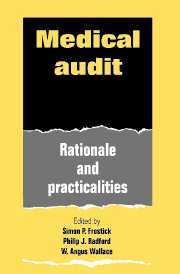Book contents
- Frontmatter
- Contents
- List of contributors
- Foreword
- Foreword
- 1 Introduction
- 2 Audit: historical and future perspectives
- 3 Audit philosophy
- 4 Medical audit: a view from the centre
- 5 Audit: a view from the Royal College of Surgeons of England
- 6 The regional viewpoint
- 7 Medical audit: the needs of the District Health Authorities
- 8 Resource management and budget holding
- 9 Unit and district information systems
- 10 Read codes and medical audit
- 11 Data capture direct from doctors
- 12 Computer systems: practice, limitations and pitfalls
- 13 Paediatric audit
- 14 Audit in obstetrics and gynaecology
- 15 Audit in general surgery
- 16 Orthopaedic audit: guidelines and hints
- 17 Installing audit in general practice and general dental practice
- 18 Clinical audit in psychiatry. Models for audit in mental health
- 19 Audit in anaesthesia
- 20 Audit in intensive care
- 21 Medical audit: lessons from the USA
- 22 Quality control in health care: the Dutch experience
- 23 Medical audit: experience from Sweden
- 24 Performance indicators
- 25 Measuring outcome and quality control
- 26 Audit: will it work?
- 27 What has been achieved so far?
- 28 A practical guide to audit
- Index
11 - Data capture direct from doctors
Published online by Cambridge University Press: 30 September 2009
- Frontmatter
- Contents
- List of contributors
- Foreword
- Foreword
- 1 Introduction
- 2 Audit: historical and future perspectives
- 3 Audit philosophy
- 4 Medical audit: a view from the centre
- 5 Audit: a view from the Royal College of Surgeons of England
- 6 The regional viewpoint
- 7 Medical audit: the needs of the District Health Authorities
- 8 Resource management and budget holding
- 9 Unit and district information systems
- 10 Read codes and medical audit
- 11 Data capture direct from doctors
- 12 Computer systems: practice, limitations and pitfalls
- 13 Paediatric audit
- 14 Audit in obstetrics and gynaecology
- 15 Audit in general surgery
- 16 Orthopaedic audit: guidelines and hints
- 17 Installing audit in general practice and general dental practice
- 18 Clinical audit in psychiatry. Models for audit in mental health
- 19 Audit in anaesthesia
- 20 Audit in intensive care
- 21 Medical audit: lessons from the USA
- 22 Quality control in health care: the Dutch experience
- 23 Medical audit: experience from Sweden
- 24 Performance indicators
- 25 Measuring outcome and quality control
- 26 Audit: will it work?
- 27 What has been achieved so far?
- 28 A practical guide to audit
- Index
Summary
Introduction
In 1987, the Department of Orthopaedic Surgery, Manchester University set out to develop a system for recording and classifying the work passing through the academic clinical unit. Like many others, we were tired of leafing through theatre logbooks to assemble series of patients for study, of depending on patently inaccurate hospital activity analysis (HAA) statistics to tell us what our workload had been, and of relying on rosy memory to retrieve our complications. Moreover, like many others, we had tried paper-based storage systems but found them, in the maelstrom of orthopaedic and trauma work in an understaffed unit, to produce more resentment than usable data.
The rising availability of computers allowed many possible solutions, but all dogged by one question – who keys in the data? We could raise a little money for hardware, though not enough for an extensive network, but salaries for data clerks were always out of the question and our doctors and secretaries were already overworked. In almost all orthopaedic units in the UK, there has for many years been a tradition of typed casenotes, based on dictation by doctors at the time of consultation. So the secretary is already transmitting diagnostic information through a keyboard – why not store the data as a by-product of her/his work?
This has remained the basis of our strategy; it has stood the test of time in several busy orthopaedic units in the last three (at the time of writing) years, with a high level of acceptability from secretaries and doctors alike.
- Type
- Chapter
- Information
- Medical Audit , pp. 138 - 155Publisher: Cambridge University PressPrint publication year: 1993

